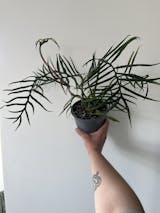




Leopard Penwiper Plant - Kalanchoe marmorata
Scientific Name
Kalanchoe marmorata (marbled plant where the parts that fall grow)
Common Name
Pen Wiper Plant, Leopard Penwiper Plant, Baby Penwiper, Spotted Kalanchoe
Origin
Native to Central and East Africa
Description
Kalanchoes get their scientific name from Chinese, meaning 'those that fall, grow'. This points to the fact that when their leaves drop, they will root and grow a whole new plant! This species has been compared (by the Sprouts team at least) to chocolate buttons, with its unusual leaf shape and the spotty patterning on the leaves make them stand out too! As they grow, the stems of the plants will raise the clusters of foliage up like a flower on a stem; the Kalanchoe will reward your care with plenty of growth and, even when it drops a leaf, more plants to scatter round!
Light
Thrives in bright, indirect light, and will benefit from a splash of morning or evening sun. It can tolerate a shadier spot a couple of metres from a window but this will result in slower growth. It will benefit from an hour or so of morning or evening sun in winter.
Water
It's much better to under-water than over-water here! Let all of the soil dry out between waters and remember it will need very little, if any, water in winter.
Humidity
These plants are adapted to low humidity so as long as they're not too close to a hot radiator, average household humidity levels will be perfectly fine.
Soil
Use a well-draining mix with components such as sand and grit. A mix designed for cacti and succulents will work well here. Repot every three years in Spring as the plant grows.
Food
Feed once every few months with a fertiliser designed for cacti and succulents
Temperature
Ideal temperature is between 15-25°C; make sure it does not get colder than 12°C in winter.
Pet-safe
No, this plant is toxic to pets and small humans.
Sprouts Top Tips
The colour of the foliage is a good indication of the health of your plant. If you notice the centre getting pale, it is probably not getting enough light; if the centre is soft and the foliage blackened, it is too wet and needs to dry out. Crispy brown edges of the leaves indicate too little water or too much sun.
Thank you it was great dealing with you.
When I saw this in Sprouts, it went instantly in my basket. I have no idea how it will look when it grows, but its so pretty and unusual. Strangely, its called a leopard when it looks like a tiger print and is in the pot like coins. So many had new growth shooting out of the pots that it was hard to pick one. Excited to see what it looks like over time.









